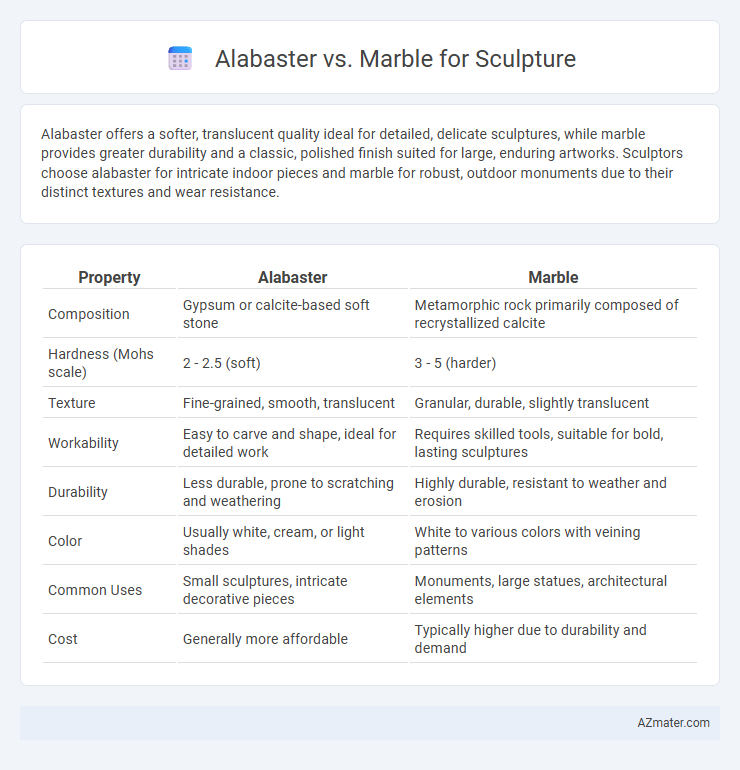Alabaster offers a softer, translucent quality ideal for detailed, delicate sculptures, while marble provides greater durability and a classic, polished finish suited for large, enduring artworks. Sculptors choose alabaster for intricate indoor pieces and marble for robust, outdoor monuments due to their distinct textures and wear resistance.
Table of Comparison
| Property | Alabaster | Marble |
|---|---|---|
| Composition | Gypsum or calcite-based soft stone | Metamorphic rock primarily composed of recrystallized calcite |
| Hardness (Mohs scale) | 2 - 2.5 (soft) | 3 - 5 (harder) |
| Texture | Fine-grained, smooth, translucent | Granular, durable, slightly translucent |
| Workability | Easy to carve and shape, ideal for detailed work | Requires skilled tools, suitable for bold, lasting sculptures |
| Durability | Less durable, prone to scratching and weathering | Highly durable, resistant to weather and erosion |
| Color | Usually white, cream, or light shades | White to various colors with veining patterns |
| Common Uses | Small sculptures, intricate decorative pieces | Monuments, large statues, architectural elements |
| Cost | Generally more affordable | Typically higher due to durability and demand |
Introduction to Alabaster and Marble
Alabaster is a soft, translucent sedimentary rock primarily composed of gypsum, renowned for its ease of carving and smooth finish, making it ideal for detailed sculpture work. Marble, a metamorphic rock formed from recrystallized carbonate minerals, boasts superior durability and a polished surface that enhances fine artistic expressions. Both materials have unique qualities; alabaster offers delicate translucency while marble provides strength and enduring beauty.
Historical Significance in Sculpture
Alabaster has been prized since ancient Egypt and Mesopotamia for its softness and translucency, allowing fine, detailed carvings and smooth finishes in religious and funerary art. Marble, favored by Classical Greek and Roman sculptors, is renowned for its durability and ability to achieve lifelike textures, making it the material of choice for iconic statues like Michelangelo's David. The historical significance of alabaster lies in its role in early, intricate decorative works, while marble's legacy is deeply rooted in monumental, enduring masterpieces that shaped Western art traditions.
Color and Aesthetic Differences
Alabaster offers a translucent, creamy white or pale color that enhances fine details with a soft, glowing appearance, ideal for delicate and intricate sculptures. Marble presents a broader range of colors, including white, gray, black, green, and pink, often featuring natural veining that creates dramatic visual contrast and depth in larger, classical sculptures. The choice between alabaster's smooth, uniform texture and marble's varied, bold aesthetics impacts the sculpture's overall visual impact and emotional resonance.
Texture and Surface Qualities
Alabaster features a smooth, fine-grained texture that allows for intricate detailing and a translucent surface quality, giving sculptures a soft, glowing appearance. Marble offers a denser, crystalline texture with a polished finish that highlights natural veining and provides a durable, reflective surface ideal for classical sculpture. The choice between alabaster and marble depends on the desired luminosity and textural finesse needed for the artwork.
Workability for Artists
Alabaster is favored by sculptors for its softness and ease of carving, allowing artists to achieve fine details with basic tools and less physical effort compared to marble. Marble's hardness and durability provide a polished finish and longevity but require advanced skill and specialized tools, making it more challenging to work with. Artists choose alabaster for intricate, delicate works and marble for grand, enduring sculptures due to these distinct workability characteristics.
Durability and Longevity
Alabaster offers a softer, more delicate texture ideal for fine detail in sculptures but has lower durability and is more prone to weathering and erosion compared to marble. Marble is significantly harder and more resistant to scratches and environmental factors, making it a preferred choice for sculptures intended to last centuries. Its crystalline structure enhances longevity, allowing marble sculptures to maintain their form and finish over time with minimal degradation.
Cost and Availability
Alabaster is generally more affordable and easier to source than marble, making it a popular choice for budget-conscious sculptors and beginners. Marble costs significantly more due to its rarity and the labor-intensive quarrying process, often limiting its availability to specialized suppliers. These cost and availability differences influence the choice of material based on project scale, desired finish, and budget constraints.
Ideal Uses in Sculpture
Alabaster is ideal for intricate sculptures requiring fine detail due to its softness and translucent quality, which allows light to pass through and enhance the artwork's depth. Marble is preferred for large-scale, durable sculptures that demand longevity and a polished, classical finish, as its hardness provides resistance to weathering and wear. Both materials offer unique textural and visual effects, making the choice dependent on the desired aesthetic and functional requirements of the sculpture.
Maintenance and Care Requirements
Alabaster requires careful maintenance due to its softness and porosity, making it susceptible to scratches, stains, and moisture damage, necessitating gentle cleaning with a soft cloth and avoidance of water exposure. Marble is more durable and resistant to moisture but still demands regular sealing to prevent staining and careful cleaning with pH-neutral solutions to maintain its polished surface. Both materials benefit from controlled environmental conditions to minimize deterioration, but alabaster sculptures need particularly cautious handling to preserve their delicate features.
Choosing the Right Material for Your Artwork
Alabaster offers a softer texture and translucent quality that enhances fine details and is ideal for intricate indoor sculptures, while marble provides durability and a classic elegance suitable for both indoor and outdoor artworks. When choosing the right material, consider alabaster's ease of carving and warm, creamy tones against marble's strength, diverse colors, and resistance to weathering. Artists seeking longevity and traditional aesthetics often prefer marble, whereas those prioritizing detailed, delicate designs and a luminous finish lean towards alabaster.

Infographic: Alabaster vs Marble for Sculpture
 azmater.com
azmater.com